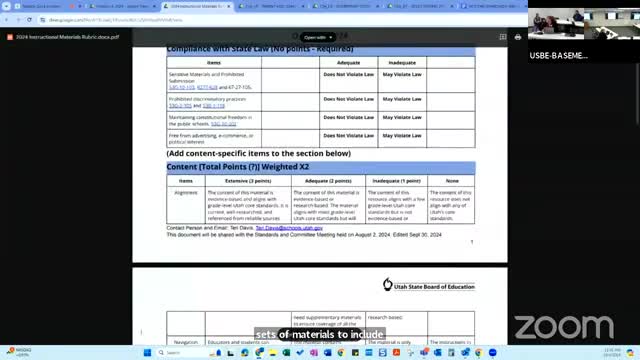Debate intensifies over child abuse prevention curriculum
September 30, 2024 | Financial Operations , Utah Board of Education, Offices, Departments, and Divisions, Organizations, Utah Executive Branch, Utah
This article was created by AI summarizing key points discussed. AI makes mistakes, so for full details and context, please refer to the video of the full meeting. Please report any errors so we can fix them. Report an error »

In a recent government meeting, officials discussed the approval process for instructional materials related to child sex abuse and human trafficking prevention. The conversation highlighted the need for clarity in the guidelines, particularly regarding the distinction between elementary and secondary education materials.
One official proposed that the board should streamline the approval process by referring to a generic rubric, which would align with minimum guidelines and reduce confusion. This suggestion came after concerns were raised about the current language in the law, which specifies that local education agencies (LEAs) must provide training and instruction on these topics for both elementary and secondary school personnel. However, the board's approval process has been limited to materials for elementary education, leading to questions about the rationale behind this restriction.
Officials acknowledged that while the law mandates training for secondary personnel, the approval of instructional materials has been confined to elementary levels due to a lack of explicit authority to approve secondary materials. This has resulted in confusion among organizations submitting materials for approval, as many believed that secondary materials were also eligible.
The discussion also touched on the need for comprehensive guidance for secondary education, with officials noting that such instruction is typically integrated into health classes. However, concerns were raised about the adequacy of this approach, particularly regarding the lack of specific guidance for secondary students.
Additionally, participants suggested enhancing the rubric by including examples of inappropriate adult behavior, particularly in the context of digital communication, which has become a significant area of concern. They emphasized the importance of addressing issues related to texting and messaging, as these platforms have been associated with numerous violations.
The meeting concluded with a call for clearer distinctions between what constitutes labor trafficking and what does not, to prevent confusion among educators and parents. Officials agreed to consider these suggestions as they work to refine the instructional materials and guidelines for child sex abuse and human trafficking prevention.
One official proposed that the board should streamline the approval process by referring to a generic rubric, which would align with minimum guidelines and reduce confusion. This suggestion came after concerns were raised about the current language in the law, which specifies that local education agencies (LEAs) must provide training and instruction on these topics for both elementary and secondary school personnel. However, the board's approval process has been limited to materials for elementary education, leading to questions about the rationale behind this restriction.
Officials acknowledged that while the law mandates training for secondary personnel, the approval of instructional materials has been confined to elementary levels due to a lack of explicit authority to approve secondary materials. This has resulted in confusion among organizations submitting materials for approval, as many believed that secondary materials were also eligible.
The discussion also touched on the need for comprehensive guidance for secondary education, with officials noting that such instruction is typically integrated into health classes. However, concerns were raised about the adequacy of this approach, particularly regarding the lack of specific guidance for secondary students.
Additionally, participants suggested enhancing the rubric by including examples of inappropriate adult behavior, particularly in the context of digital communication, which has become a significant area of concern. They emphasized the importance of addressing issues related to texting and messaging, as these platforms have been associated with numerous violations.
The meeting concluded with a call for clearer distinctions between what constitutes labor trafficking and what does not, to prevent confusion among educators and parents. Officials agreed to consider these suggestions as they work to refine the instructional materials and guidelines for child sex abuse and human trafficking prevention.
View full meeting
This article is based on a recent meeting—watch the full video and explore the complete transcript for deeper insights into the discussion.
View full meeting

